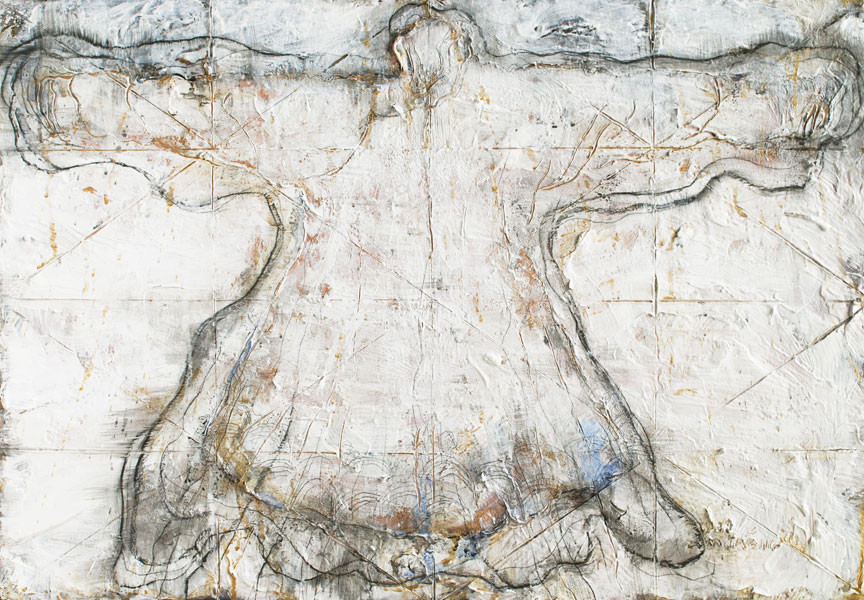Built on the previous “Far and Away North” series, I continue to be inspired by themes of memories, history, and remaining cultural heritages, from ancient towers in great Angkor Wat and sporadic village communal houses in Vietnam’s rural north to old costumes used by emperors and royal families during Le’s and Trinh’s dynasties in the 17th century.
As I alter the structures of the landscapes in my paintings, I by chance get to have access to detailed architectural drawings of some village communal houses in the north of Vietnam. When I look at the communal houses independently of the space, they look like they are expanded in spatial and non-temporal dimensions. This is very important because it gives me a rather different view of a living building with an appearance independent of what is presented in the drawings. Then you are no longer dependent on their real images. Instead, your thoughts are opened up and become more liberal. The drawing metrics are no longer important now that my focus is only to look at them from altering spatial and structural aspects. Based on these, I now have all the freedom to develop newer structures and reinvent them with a new spatial layer based on the old one. Then creating a new structure from an existing drawing will give the landscape a new and liberal structure at a higher level, and the painting is like part of the geometric structure of the building under restoration, just like an architectural perspective drawing. The invented space looks newer and more multi-directional, which allows for personal exploration of each and every detail. On the background of this new structure, I connect the sketches in geometric forms, creating a transparent view of the landscape, giving it a mysterious and unpredictable look. However, as I develop paintings from drawings, I also don't let practical experiences pass me by. I keep coming back for several times to village communal houses where I have been to just to see the space and the context more clearly.
As for the formation of ancient constructions in northern Vietnam, pagodas and communal houses were built based on a combination of natural factors and feng-shui perceptions. A typical one would not be of a huge scale. Instead it would be built based on existing natural geographical and contextual situations. They were built to meet religious and belief needs, or as a result of an influence by some individuals in Vietnamese feudal society. Through all the changes of the many centuries, to me, anything that remains is precious, as it has survived the filtering and selection by nature and by human kind. To this point, Angkor Wat as we see it today is a great example. When you arrive in Angkor Wat, you will feel the exposure and connectivity between Man and Nature. That’s how the themes in my paintings have moved from Vietnam’s iconic contemporary buildings to historical ones. It’s like a journey to the past, and it helps you see the connections between natural, social, historical and memorial elements. When I work with historical buildings, I want to see them in their pristine stage, and I tend to use colors to create feelings of closest proximity to the nature. Therefore I use colors of soil, mud, ash, steam, firewood, gold, silver, and ancient lacquer red hidden in old appearances.
I don’t attempt to represent the nature. Instead, I let nature lead the journey in my work. Sometimes a question keeps popping up in my mind: “Where will arts lead you to eventually?” We strive to make our arts newer and fresher. Is it really important, or are arts like a journey back to the nature – you go far and but then you will always come back to the point of origin? All changes and evolutions are close to impermanence. In arts, and in life, there always seems to be something like the existence of those old temples, towers, and costumes. The ultimate choice is always made by the nature – where there are things beyond human decision power.”
Hà Nội 17/06/2014
Hà Mạnh Thắng

